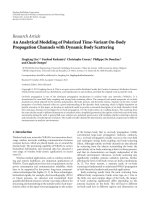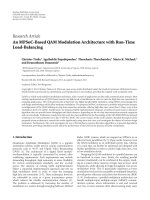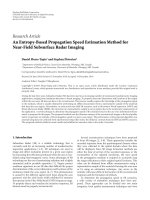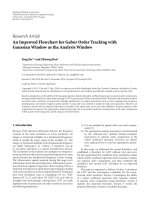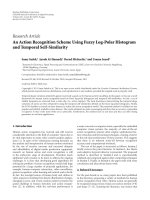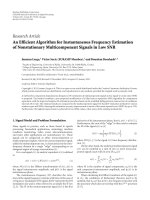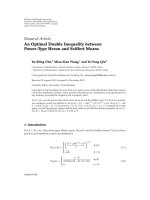Báo cáo hóa học: " Research Article An Effective Numerical Method and Its Utilization to Solution of Fractional Models Used in Bioengineering Applications" docx
Bạn đang xem bản rút gọn của tài liệu. Xem và tải ngay bản đầy đủ của tài liệu tại đây (805.91 KB, 14 trang )
Hindawi Publishing Corporation
Advances in Difference Equations
Volume 2011, Article ID 652789, 14 pages
doi:10.1155/2011/652789
Research Article
An Effective Numerical Method and Its
Utilization to Solution of Fractional Models
Used in Bioengineering Applications
Ivo Petr
´
a
ˇ
s
Institute of Control and Informatization of Production Processes, Faculty of BERG,
Technical University of Ko
ˇ
sice, B. N
ˇ
emcovej 3, 042 00 Ko
ˇ
sice, Slovakia
Correspondence should be addressed to Ivo Petr
´
a
ˇ
s,
Received 13 December 2010; Accepted 1 February 2011
Academic Editor: J. J. Trujillo
Copyright q 2011 Ivo Petr
´
a
ˇ
s. This is an open access article distributed under the Creative
Commons Attribution License, which permits unrestricted use, distribution, and reproduction in
any medium, provided the original work is properly cited.
This paper deals with the fractional-order linear and nonlinear models used in bioengineering
applications and an effective method for their numerical solution. The proposed method is based
on the power series expansion of a generating function. Numerical solution is in the form of the
difference equation, which can be simply applied in the Matlab/Simulink to simulate the dynamics
of system. Several illustrative examples are presented, which can be widely used in bioengineering
as well as in the other disciplines, where the fractional calculus is often used.
1. Introduction
Recently, fractional calculus has played an increasing role in modeling complex phenomena
in the fields of physics, chemistry, biology, and engineering e.g., 1–4. The main
characteristic of fractional derivatives, or more precisely derivatives of positive real order,
is so called the “memory effect”. It is well known that the state of many systems biological,
electrochemical, viscoelastic, etc. at a given time depends on their configuration at previous
times. The fractional derivative takes into account this history in its definition as a
convolution with a function whose amplitude decays at earlier times as a power-law. Thus,
the fractional derivative is natural to use when modeling biological systems in various
bioengineering applications.
In this paper, we offer applications of fractional calculus in bioengineering, which
are described by the fractional differential equations. Paper is organized as follows:
basic definitions of fractional calculus, fractional-order systems and numerical method are
presented first in Section 2. Three representative fractional-order models often used in
bioengineering are described and numerically solved in Section 3.InSection 4 the questions
of numerical analysis are discussed. Some conclusion remarks are mentioned in Section 5.
2 Advances in Difference Equations
2. Preliminaries
2.1. Fractional Calculus
Fractional calculus is a topic in mathematics that is more than 300 years old. The idea
of fractional calculus was suggested early in the development of regular integer-order
calculus, with the first literature reference being associated with a letter, from Leibniz to
L’Hospital in 1695. In this letter the half-order derivative was first mentioned.
There are several definitions of the fractional derivative/integral as a one common
operator known as “differintegral” see, e.g., 4–6:
The Riemann-Liouville RL definition is given as
a
D
r
t
f
t
1
Γ
n − r
d
n
dt
n
t
a
f
τ
t − τ
r−n1
dτ,
2.1
for n − 1 <r<n and where Γ· is the Gamma function.
The Caputo’s definition of fractional derivatives can be written as
a
D
r
t
f
t
1
Γ
n − r
t
a
f
n
τ
t − τ
r−n1
dτ,
2.2
for n − 1 <r<n.
If we consider k t−a/h, where a is a real constant and · means the integer part,
we can write the Gr
¨
unwald-Letnikov GL definition as
a
D
r
t
f
t
lim
h → 0
1
h
r
k
j0
−1
j
r
j
f
t − jh
, 2.3
where a and t are the bounds of operation for
a
D
r
t
ft. Usually, we assume lower boundary
a 0.
For many engineering applications the Laplace transform methods are often used. The
Laplace transform of the RL, the GL, and Caputo’s fractional derivative/integral, under zero
initial conditions for order r is given by 5:
£
a
D
±r
t
f
t
; s
s
±r
F
s
. 2.4
A function, which plays a very important role in the fractional calculus, was in fact
introduced by Humbert and Agarwal 7. It is a two-parameter function of the Mittag-Leffler
type defined as 4:
E
α,β
z
∞
k0
z
k
Γ
αk β
,
α>0,β>0
.
2.5
Note that fractional calculus holds many important and interesting properties, which
were described for instance in 3–5.
Advances in Difference Equations 3
2.2. Fractional-Order Systems
There are several possible interpretations of the fractional-order systems. Here are mentioned
three of them.
A general fractional-order linear system can be described by a fractional differential
equation of the form 4:
a
n
D
α
n
y
t
··· a
1
D
α
1
y
t
a
0
D
α
0
y
t
b
m
D
β
m
u
t
··· b
1
D
β
1
u
t
b
0
D
β
0
u
t
,
2.6
where D
γ
≡
0
D
γ
t
denotes the Riemann-Liouville, Caputo’s or Gr
¨
unwald-Letnikov frac-
tional derivative depending on initial conditions and their physical meaning or by the corre-
sponding transfer function of incommensurate real orders of the following form 4:
G
s
b
m
s
β
m
··· b
1
s
β
1
b
0
s
β
0
a
n
s
α
n
··· a
1
s
α
1
a
0
s
α
0
Q
s
β
k
P
s
α
k
,
2.7
where a
k
k 0, ,n, b
k
k 0, ,m are constants, and α
k
k 0, ,n, β
k
k
0, ,m are arbitrary real or rational numbers and without loss of generality they can be
arranged as α
n
> ···>α
1
>α
0
,andβ
m
> ···>β
1
>β
0
.
The fractional-order linear time-invariant system can also be represented by the
following state-space model:
0
D
r
t
x
t
Ax
t
Bu
t
,
y
t
Cx
t
,
2.8
where x ∈ R
n
, u ∈ R
m
,andy ∈ R
p
are the state, input and output vectors of the system and A ∈
R
n×n
, B ∈ R
n×m
, C ∈ R
p×n
,andr r
1
,r
2
, ,r
n
T
are the fractional orders. If r
1
r
2
··· r
n
≡ r,
system 2.8 is called a commensurate-order system, otherwise it is an incommensurate-order
system.
In this paper, we will also consider the general incommensurate fractional-order
nonlinear system represented as follows:
0
D
r
i
t
x
i
t
f
i
x
1
t
,x
2
t
, ,x
n
t
,t
x
i
0
c
i
,i 1, 2, ,n,
2.9
where f
i
are nonlinear functions and c
i
are initial conditions. The vector representation of
2.9 is:
D
r
x f
x
, 2.10
where r r
1
,r
2
, ,r
n
T
for 0 <r
i
< 2, i 1, 2, ,n and x ∈ R
n
.
4 Advances in Difference Equations
The equilibrium points of system 2.10 are calculated via solving the following
equation
f
x
0, 2.11
and we suppose that E
∗
x
∗
1
,x
∗
2
, ,x
∗
n
is an equilibrium point of the fractional-order
nonlinear system 2.10.
2.3. Discrete Time Approximation of Fractional Calculus: Numerical Method
In general, if a function ft is approximated by a grid function, fkh, where h is the grid
size, the approximation for its fractional derivative of order α can be expressed as 8:
y
h
kh
h
∓r
ω
z
−1
±r
f
h
kh
,
2.12
where z
−1
is the backward shift operator and ωz
−1
is a generating function. This generating
function and its expansion determine both the form of the approximation and the coefficients
9. In this way, the discretization of continuous fractional-order differentiator/integrator
s
±r
r ∈ R can be expressed as s
±r
≈ ωz
−1
±r
. It is known that the forward difference
rule is not suitable for applications to causal problems 8, 9.
As a generating function, ωz
−1
can be used in generally the following formula 10:
ω
z
−1
1
βT
1 − z
−1
γ
1 − γ
z
−1
, 2.13
where β and γ are denoted the gain and phase tuning parameters, respectively, and T is
sampling period. For example, when β 1andγ {0, 1/2, 7/8, 1, 3/2}, the generating
function 2.13 becomes the forward Euler, the Tustin, the Al-Alaoui, the backward Euler, the
implicit Adams rules, respectively. In this sense the generating formula can be tuned more
precisely.
The expansion of the generating functions can be done by power series expansion
PSE. It is very important to note that PSE scheme leads to approximations in the form of
polynomials of degree p, that is, the discretized fractional order derivative is in the form of
finite impulse response FIR filters, which have only zeros 11.
In this paper, for directly discretizing s
±r
, 0 <r<1, we will concentrate on the FIR
form of discretization where as a generating function we will adopt a backward Euler rule.
The mentioned operator, obtained from 2.13 for β γ 1, raised to power ±r, has the form
ω
z
−1
±r
1 − z
−1
T
±r
.
2.14
Advances in Difference Equations 5
Then, the resulting transfer function, approximating the fractional-order operators,
can be obtained by applying the relationship 12:
Y
z
T
∓r
PSE
1 − z
−1
±r
F
z
, 2.15
where Yz is the Z transform of the output sequence ykT, Fz is the Z transform of the
input sequence fkT,andPSE{u} denotes the expression, which results from the power
series expansion of the function u.
Doing so gives 13:
D
±r
z
Y
z
F
z
T
∓r
PSE
1 − z
−1
±r
T
∓r
P
p
z
−1
,
2.16
where D
±r
z denotes the discrete equivalent of the fractional-order operator, considered as
processes, and P
p
z
−1
is the polynomial with degree p of variable z
−1
.
By using the short memory principle 4, the discrete equivalent of the fractional-order
integrodifferential operator, ωz
−1
±r
, is given by
D
±r
z
ω
z
−1
±r
T
∓r
z
−L/T
L/T
j0
−1
j
±r
j
z
L/T−j
, 2.17
where L is the memory length and −1
j
±r
j
are binomial coefficients c
±r
j
, j 0, 1,
where 14
c
±r
0
1,c
±r
j
1 −
1
±r
j
c
±r
j−1
.
2.18
For practical numerical calculation of the fractional derivative and integral we can
derive the formula from relation 2.17, where the sampling period T is in numerical
evaluation replaced by the time step of calculation h, then we get
k−L/h
D
±r
kh
f
t
≈ h
∓r
k
jv
−1
j
±r
j
f
k−j
h
∓r
k
jv
c
±r
j
f
k−j
, 2.19
where v 0fork<L/h or v k − L/h for k>L/h in the relation 2.19.Byusing
arelation2.14 we obtained a first-order approximation Oh of the fractional derivative of
order r. Another possibility for the approximation is use, the trapezoidal rule, that is, the use
of the generating function 2.13 for β 1,γ 1/2 and then the PSE, which is convergent of
order 2. Other forms of generation functions for higher-order approximation of the fractional
order derivative r are presented in 9.
6 Advances in Difference Equations
Obviously, for this simplification we pay a penalty in the form of some inaccuracy. If
ft ≤ M, we can easily establish the following estimate for determining the memory length
L, providing the required accuracy 4:
L ≥
M
|
Γ
1 − r
|
1/r
.
2.20
An evaluation of the short memory effect and convergence relation of the error between short
and long memory were clearly described and also proved in 4.
For general numerical solution of the fractional differential equation, let us consider
the following initial value problem
a
D
r
t
y
t
f
y
t
,t
, 2.21
with initial conditions y
k
0y
k
0
,k 0, 1, ,n − 1, where n − 1 <r<n.Using
approximation 2.19, we obtain the numerical solution, which can be expressed as
y
t
k
f
y
t
k
,t
k
h
r
−
k
jv
c
r
j
y
t
k−j
, 2.22
where t
k
kh. For the memory term expressed by sum, a “short memory” principle can be
used or without using “short memory” principle, we put v 1 for all k in 2.22.
3. Fractional-Order Models in Bioengineering Applications
There are many f ractional-order models, which were already used in bioengineering ap-
plications as for example 3, 4, 15: model of neuron, bioelectrode model, model of respiratory
mechanics, compartmental model of pharmacokinetics, and so f orth, In this section we
mention and describe only three of them, namely model of the cells, nuclear magnetic
resonance NMR model, and Lotka-Volterra parasite-host or predator-prey model.
3.1. Fractional-Order Viscoelastic Models of Cells
Cells have an essential biological roles and often change shape, attach and detach from
surface, and sometimes divide. Such activities require the deformation in response to local
stress. The rheological behavior of these cells can be modeled with the following fractional
differential equation 3:
σ
t
G
s
θ
t
λ
0
D
α
t
θ
t
μ
dθ
t
dt
,
3.1
where σ is stress, θ is strain, G
s
is the static elastic modulus, λ is fractional relaxation time
constant, and μ is the viscosity.
Advances in Difference Equations 7
If we apply the Laplace transform to system 3.1, assuming that the initial conditions
are all zeros, we obtain
G
s
Σ
s
Θ
s
G
s
λs
α
μs.
3.2
As it was mentioned in 3, the parameter G
s
can be neglected. For a step function ut
in applied stress, σtσ
0
ut, the creep response can be written as
Θ
s
Σ
0
s
μs λs
α
Σ
0
s
1−α−2
μ
s
1−α
λ/μ
.
3.3
The inverse Laplace transform of t his expression can be written by using a Laplace
transform of the Mittag-Leffler function 4:
£
t
β−1
E
γ,β
−zt
γ
s
γ−β
s
γ
z
,
3.4
and we obtain an analytical solution in the form
θ
t
Σ
0
μ
tE
1−α,2
−
λ
μ
t
1−α
.
3.5
For numerical solution of the fractional differential equation 3.1 for G
s
0, we can
use relations 2.18 and 2.19. The resulting difference equation has the form
θ
t
k
Σ
0
μh
−1
θ
t
k−1
− λh
−α
k
jv
c
α
j
θ
t
k−j
λh
−α
μh
−1
, 3.6
where t
k
kh for k 1, 2, 3, ,N, where N T
sim
/h and h is time step of calculation, and
θt
0
is obtained from initial condition, for example, θt
0
0 for zero initial condition.
Let us assume the following model parameters: λ μ Σ
0
1, zero initial condition,
T
sim
5sec,h 0.001, and v 1.
Comparison of the analytical solution 3.5 and the numerical solution 3.6 of the
fractional differential equation 3.1 for the parameters G
s
0, λ μ Σ
0
1, zero initial
condition, T
sim
5sec,h 0.001, and v 1 is depicted in Figure 1.
As we can observe in Figure 1, the numerical solution fits the analytical solution and
we can say that both solutions are consistent.
3.2. Fractional-Order Bloch Equations in NMR
In physics and bioengineering, specifically in NMR or magnetic resonance imaging, the
Bloch equations are a set of macroscopic equations that are used to calculate the nuclear
magnetization M M
x
t,M
y
t,M
z
t as a function of time when relaxation times are
T
1
spin-lattice and T
2
spin-spin. The physical basis for T
1
relaxation involves the protons
8 Advances in Difference Equations
losing their energy to the surrounding lattice, hence the name spin-lattice relaxation. T
2
involves the loss of phase coherence between the protons processing in the transverse plane.
Different tissues in the body have different values of T
1
and T
2
. The values depend on the
strength of the magnetic field.
Now, we consider the fractional-order Bloch equations, where integer-order deriva-
tives are replaced by fractional-order ones. Mathematical description of the fractional-order
system with Caputo’s derivatives is expressed as 16
0
D
q
1
t
M
x
t
ω
0
M
y
t
−
M
x
t
T
2
,
0
D
q
2
t
M
y
t
−ω
0
M
x
t
−
M
y
t
T
2
,
0
D
q
3
t
M
z
t
M
0
− M
z
t
T
1
,
3.7
where q
1
, q
2
,andq
3
are the derivative orders. Here, ω
0
, T
1
,andT
2
have the units of sec
q
to
maintain a consistent set of units for the magnetization.
Numerical solution of Bloch equations 3.7 was obtained by using the relationship
2.22, which leads to solution in the form 17:
M
x
t
k
ω
0
M
y
t
k−1
−
M
x
t
k−1
T
2
h
q
1
−
k
jv
c
q
1
j
M
x
t
k−j
,
M
y
t
k
−ω
0
M
x
t
k
−
M
y
t
k−1
T
2
h
q
2
−
k
jv
c
q
2
j
M
y
t
k−j
,
M
z
t
k
M
0
− M
z
t
k−1
T
1
h
q
3
−
k
jv
c
q
3
j
M
z
t
k−j
,
3.8
where T
sim
is the simulation time, k 1, 2, 3 ,N,forN T
sim
/h,andM
x
0, M
y
0,
M
z
0 is the start point initial conditions.
Comparison of the proposed numerical solution 3.8 with an analytical solution
has been done in 17 and obtained results show a good consistency of both solutions. In
aforementioned work the Matlab function and the Matlab/Simulink model for solution of
the fractional-order Bloch equations 3.7 have also been created, which can be widely used
for simulations with various parameters ω
0
, T
1
, T
2
,andM
0
for desired simulation time T
sim
and initial conditions M
x
0, M
y
0, M
z
0.
Let us consider the following parameters for tissue—gray matter of brain—for a
magnetic field strength of 1.5 T from 18: T
1
900 ms
q
, T
2
100 ms
q
, ω
0
401 rad/sec
q
,
equilibrium M
0
100, orders q ≡ q
1
q
2
q
3
0.9, and q ≡ q
1
q
2
q
3
1.0, respectively.
Numerical solution state space trajectory of the fractional-order Bloch equations 3.7
with parameters: q ≡ q
1
q
2
q
3
0.9, T
1
900 ms
q
, T
2
100 ms
q
, M
0
100,
ω
0
401 rad/sec
q
, and initial conditions M
x
00, M
y
0100, M
z
00 obtained by
equations 3.8 for T
sim
1sec,h 0.0005, and v 1isdepictedinFigure 2. State space trajec-
tory for the integer-order Bloch equations with the same parameters is depicted in Figure 3.
Advances in Difference Equations 9
0 0.5 1 1.5 2 2.5 3 3.5 4 4.5 5
0
0.2
0.4
0.6
0.8
1
1.2
1.4
1.6
1.8
Time (s)
θ(t)
Analytical solution
Numerical solution
Figure 1: Comparison of analytical and numerical solutions of fractional-order viscoelastic models of cell
3.3 for simulation time 5 sec, step h 0.001, and v 1in3.6.
−40
−20
0
20
40
60
80
−50
0
50
100
0
10
20
30
40
50
60
70
M
x
(t
)
M
y
(
t)
M
z
(t)
Figure 2: Numerical solutions of fractional-order q ≡ q
1
q
2
q
3
0.9 Bloch 3.7 in state space for
simulation time 1 sec, h 0.0005, and v 1in3.8.
We can observe in both figures that fractional orders in the Bloch equations provide
expanded model with different behavior for describing a more general NMR, which can find
applications in complex materials exhibiting memory.
3.3. Fractional-Order Lotka-Volterra System
The fractional-order Lotka-Volterra or fractional-order predator-prey model or parasite-
host system was proposed and described as 19:
0
D
q
1
t
x
t
x
t
α − rx
t
− βy
t
,
0
D
q
2
t
y
t
y
t
δx
t
− γ
,
3.9
10 Advances in Difference Equations
−100
−50
0
50
100
−100
−50
0
50
100
0
10
20
30
40
50
60
70
M
x
(t)
M
y
(t)
M
z
(t)
Figure 3: Numerical solutions of integer-order q ≡ q
1
q
2
q
3
1.0 Bloch equations 3.7 in state space
for simulation time 1 sec, h 0.0005, and v 1in3.8.
where 0 <q
1,2
≤ 1,x≥ 0,y≥ 0 are prey and predator densities, respectively, and all
constants r, α, β, γ, δ are positive. For r 0andq
1
q
2
1 we obtain a well-known model
proposed by Alfred Lotka in 1910 and independently by Vito Volterra in 1926.
The stability analysis and numerical solutions of such kind of system have been
already studied in 19. There are two equilibria, when the system 3.9 is solved for x and y.
The above system of equations yields to E
1
0; 0 and E
2
λ/δ; α/β if r 0. The stability
of the equilibrium point E
1
is of importance. If it were stable, nonzero populations might be
attracted towards it. However, as the fixed point at the origin is a saddle point, and hence
unstable, we find that the extinction of both species is difficult in the model. The second
fixed point E
2
is not hyperbolic, so no conclusions can be drawn from the linear analysis.
However, the system admits a constant of motion and the level curves are closed trajectories
surrounding the fixed point. Consequently, the levels of the predator and prey populations
cycle and oscillate around this fixed point.
Numerical solution of the fractional-order Lotka-Volterra system 3.9 is given by
using a relation 2.22 as
x
t
k
x
t
k−1
α − βy
t
k−1
− rx
t
k−1
h
q
1
−
k
jv
c
q
1
j
x
t
k−j
,
y
t
k
−γy
t
k−1
δx
t
k
y
t
k−1
h
q
2
−
k
jv
c
q
2
j
y
t
k−j
,
3.10
where T
sim
is the simulation time, k 1, 2, 3 ,N,forN T
sim
/h,andx0, y0 is the
start point initial conditions.
Let us assume the following parameters of system 3.9: α 2,β 1,γ 3,δ 1,r
0 and orders q
1
q
2
1.0andq
1
q
2
0.9, respectively.
Numerical solution state plane trajectory of the fractional-order Lotka-Volterra
equations 3.9 with parameters: α 2,β 1,γ 3,δ 1,r 0, and initial conditions
x01, y02 obtained by equations 3.10 for T
sim
60 sec, h 0.005, and v 1
is depicted in Figure 4. State plane trajectory for the integer-order Lotka-Volterra equations
with the same parameters is depicted in Figure 5.
Advances in Difference Equations 11
012345678
0
1
2
3
4
5
6
x(t)
y(t)
Figure 4: Numerical solutions of fractional-order q ≡ q
1
q
2
0.9 Lotka-Volterra equations 3.9 in state
plane for simulation time 60 sec, h 0.005, and v 1in3.10.
01234567
0
1
2
3
4
5
6
x(t)
y(t)
Figure 5: Numerical solutions of integer-order q ≡ q
1
q
2
q
3
1.0 Lotka-Volterra equations 3.9 in
state plane for simulation time 60 sec, h 0.005, and v 1in3.10.
According to knowledge of author, there is no exact analytical solution of the
fractional-order Lotka-Volterra equations, which could be compared with the numerical
solution. The only possibility is to compare proposed numerical method with an approximate
solution obtained via different numerical methods as for example homotopy perturbation
method, variational iteration method, and so on.
4. Discussion
The proposed numerical method is also known as Euler method which is based on the
Gr
¨
unwald-Letnikov definition of the fractional derivative and can be used for numerical
12 Advances in Difference Equations
solution of the fractional differential equation even if the fractional-order derivative in
differential equation is Caputo’s or Riemann-Liouville type. It is based on the fact that for
a wide class of functions, all three definitions of the fractional derivatives are equivalent
4.
Sometimes the Euler method is not accurate enough; it only has order one. We have
to do a numerical analysis, which consists of not only the design of numerical methods, but
also analysis of three main concepts.
i Consistency and order. Tell us how well it approximates the solution, we can say,
method is consistent if it has an order greater than 0. The method used in this
article has order 1 and therefore it is consistent. Order is determined by generating
function. Consistency is a necessary condition for convergence, but not sufficient.
ii Convergence. It means whether the method approximates the solution, in other
words, a numerical method is said to be convergent if the numerical solution ykh
approaches the exact solution yt asthetimestepsizeh goes to 0. The method
described in this article is convergent because the following condition is satisfied:
lim
h → 0
max
k0,1, ,T
sim
/h
y
kh
− y
t
0,
4.1
for T
sim
> 0. For instance, we can observe a good result in comparison of exact
solution and numerical solution shown in Figure 1. The time step was h 0.001.
iii Stability and stiffness. It says whether errors are damped out. For some differential
equations, application of standard methods exhibit instability in the solutions,
though other methods may produce stable solutions. This behavior in the equation
is described as stiffness. Method described in article provides a stable solution.
The numerical method 2.22 proposed for the initial value problem 2.21 holds all
three above-mentioned conditions and can be used for solution of linear and nonlinear
fractional differential equations. Based on performed experiments, we can consider what is
the optimal choice of time step h in order to get maximum accuracy in the approximated
solution for minimum computational cost. We have used the time steps h 0.005, h 0.001,
and 0.0005. Numerical solutions show than we may accept the results obtained in this way.
The size of the time step also depends on desired relative error in the solution.
5. Conclusions
In this paper, we presented an effective numerical method and its application to solution
of linear and nonlinear models of fractional order used in bioengineering applications. For
some of them, Matlab functions 15, 17, 20 were also published. Here, three illustrative
examples have been presented as well. It is worth to note that some other methods are also
appropriate for solution of such kind of problem, for example predictor-corrector method
19, Podlubny’s matrix approach 21, 22, quadrature formula approach 23, multistep
method 24, and frequency Oustaloup’s method 6, but it has some restrictions, especially
for the fractional nonlinear models 25. In further work, it is necessary to improve this
method with proper mathematical analysis and exact determination of the time step size h.
Advances in Difference Equations 13
Acknowledgment
This work was supported in part by the Slovak Grant Agency for Science under Grants
VEGA: 1/0390/10, 1/0497/11, 1/0746/11, Grants APVV-0040-07 and SK-PL-0052-09.
References
1 R. Caponetto, G. Dongola, L. Fortuna, and I. Petr
´
a
ˇ
s, Fractional Order Systems: Modeling and Control
Applications, World Scientific, Singapore, 2010.
2 R. Hilfer, Applications of Fractional Calculus in Physics, World Scientific, River Edge, NJ, USA, 2000.
3 R. L. Magin, Fractional Calculus in Bioengineering, Begell House, 2006.
4 I. Podlubny, Fractional Differential Equations, vol. 198 of Mathematics in Science and Engineering,
Academic Press, San Diego, Calif, USA, 1999.
5 K. B. Oldham and J. Spanier, The Fractional Calculus, Academic Press, New York, NY, USA, 1974.
6 A. Oustaloup, La D
´
erivation non Enti
`
ere, Hermes, Paris, France, 1995.
7 P. Humbert and R. P. Agarwal, “Sur la fonction de Mittag-Leffler et quelques-unes de ses
g
´
en
´
eralisations,” Bulletin des Sciences Math
´
ematiques, vol. 77, pp. 180–185, 1953.
8 R. Gorenflo, “Fractional calculus: some numerical methods,” in Fractals and Fractional Calculus in
Continuum Mechanics, vol. 378 of CISM Courses and Lectures, pp. 277–290, International Centre for
Mechanical Sciences, Udine, Italy, 1996.
9 Ch. Lubich, “Discretized fractional calculus,” SIAM Journal on Mathematical Analysis,vol.17,no.3,pp.
704–719, 1986.
10 R. S. Barbosa, J. A. Tenreiro Machado, and M. F. Silva, “Time domain design of fractional
differintegrators using least-squares,” Signal Processing, vol. 86, no. 10, pp. 2567–2581, 2006.
11 L’. Dor
ˇ
c
´
ak, I. Petr
´
a
ˇ
s, J. Terp
´
ak, and M. Zborovjan, “Comparison of the methods for discrete
approximation of the fractional-order operator,” Acta Montanistica Slovaca, vol. 8, no. 4, pp. 236–239,
2003.
12 B. M. Vinagre, I. Podlubny, A. Hern
´
andez, and V. Feliu, “Some approximations of fractional order
operators used in control theory and applications,” Fractional Calculus & Applied Analysis, vol. 3, no.
3, pp. 231–248, 2000.
13 B. M. Vinagre, Y. Q. Chen, and I. Petr
´
a
ˇ
s, “Two direct Tustin discretization methods for fractional-
order differentiator/integrator,” Journal of the Franklin Institute, vol. 340, no. 5, pp. 349–362,
2003.
14 L’. Dor
ˇ
c
´
ak, Numerical Models for the Simulation of the Fractional-Order Control Systems, The Academy of
Science, Institute for Experimental Physics, Ko
ˇ
sice, Slovakia, 1994.
15 I. Petr
´
a
ˇ
s and R. L. Magin, “Numerical solution of two compartmental biological system model,”
in Proceedings of the 4th IFAC Workshop on Fractional Differentiation and Its Applications,Universityof
Extremadura, Badajoz, Spain, October 2010.
16 R. Magin, X. Feng, and D. Baleanu, “Solving the fractional order Bloch equation,” Concepts in Magnetic
Resonance A, vol. 34, no. 1, pp. 16–23, 2009.
17 I. Petr
´
a
ˇ
s, “Modeling and numerical analysis of fractional-order Bloch equations,” Computers and
Mathematics with Applications, vol. 61, no. 2, pp. 341–356, 2011.
18 A. Webb, Introduction to Biomedical Imaging, John Wiley & Sons, New York, NY, USA, 2003.
19 E. Ahmed, A. M. A. El-Sayed, and H. A. A. El-Saka, “Equilibrium points, stability and numerical
solutions of fractional-order predator-prey and rabies models,” Journal of Mathematical Analysis and
Applications, vol. 325, no. 1, pp. 542–553, 2007.
20 I. Petr
´
a
ˇ
s, “Fractional Order Chaotic Systems Matlab toolbox
,” MathWorks, Inc., FileExchange, 2010,
/>21 I. Podlubny, “Matrix approach to discrete fractional calculus,” Fractional Calculus & Applied Analysis,
vol. 3, no. 4, pp. 359–386, 2000.
22 I. Podlubny, A. Chechkin, T. Skovranek, Y. Chen, and B. M. Vinagre Jara, “Matrix approach to discrete
fractional calculus. II. Partial fractional differential equations,” Journal of Computational Physics, vol.
228, no. 8, pp. 3137–3153, 2009.
23 K. Diethelm, “An algorithm for the numerical solution of differential equations of fractional order,”
Electronic Transactions on Numerical Analysis, vol. 5, pp. 1–6, 1997.
14 Advances in Difference Equations
24 Ch. Lubich, “Fractional linear multistep methods for Abel-Volterra integral equations of the first
kind,” IMA Journal of Numerical Analysis, vol. 7, no. 1, pp. 97–106, 1987.
25 M. S. Tavazoei and M. Haeri, “Limitations of frequency domain approximation for detecting chaos in
fractional order systems,” Nonlinear Analysis: Theory, Methods & Applications, vol. 69, no. 4, pp. 1299–
1320, 2008.



